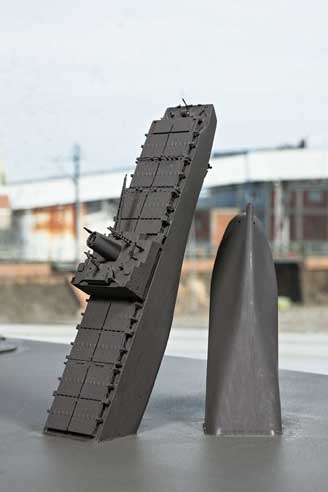The Nordic Biennial, aka Momentum, takes place in the town of Moss on the outskirts of Oslo. For the seventh edition, two Scandinavian curators harbouring diverse practices – Power Ekroth and Erland Hammer – decided to ‘agree to disagree’: that is, to create two parallel exhibitions. Theorists might refer to this thematic conflict as ‘positive antagonism’, wherein friction stemming from disagreement can fuel change or motivate a redirection of energies.
What matters more than deciding to get along, or otherwise, is what results: combined energies, going against the grain or doing or saying nothing. Revolts and rebellions can be useless if the idea behind an action is misinformed; motivations should aim for transparency. Whether or not art can be apolitical is a question for this event. Art is perceived to be as significant as a transformative political revolution by only a handful of appreciators.
Unlike Momentum 6, which involved five Scandinavian curators, a single theme and more exhibition spaces, the current biennial downplays collaboration. This year, Momentum Kunsthall – a former brewery in the city centre – is the primary exhibition space, with Heilmannparken, a nineteenth-century garden, and the entrance area to Møllebyen and Momentum Kunsthall providing additional space. The curators have divided these spaces, with Ekroth focusing more on the external public areas. No singular conclusion arises from either curator’s work; how one views these radically different exhibitions remains the responsibility of a searching audience.
both curators confront thematic relevance, questioning its necessity
Still, both curators confront thematic relevance, questioning its necessity. The artists in Ekroth’s share of the biennial, Six Impossible Things Before Breakfast, do not fit into any prepackaged concept; they cajole the viewer to enter other worlds (the title references Alice’s Adventures in Wonderland), some of them delusional yet deserving inspection.
In Tower of Babel (2011), Iranian artist Goran Hassanpour shares his sculptural interpretation of Babylon based upon how he privately imagined this utopia to be at an amorphous point in time – when the world was sublime and unfettered. Together, these works invite viewers to reexamine their approaches to the truisms and fallacies of art as tool or saviour.
Ekroth suggests in her text for the exhibition one political axiom inspired by Marx & Engels: ‘Art is both “base” and “superstructure”… Every-day life [is] where all transactions between people happen within the “base”, where the forces and relations of production such as the division of labour and property exist; the relations into which people enter to produce the necessities of life.
Then there is the ‘superstructure’ which can be described as whatever else we need to make the base function: the laws, the economic structure, the ideology and the history of the society – and how one regards oneself within the society is of course part of this.’
Forces at the base (eg, the Internet) affect the superstructure (eg, culture and education), yet art is considered the conjoining thread and ticket to move among these spheres – and citizens, for Ekroth, must reevaluate how the base relates to the overarching schematics via frank confrontation and analysis of these components.
Highlighting forces that manipulate creativity, Ekroth emphasises in her text the importance of artists’ freedom to create and viewers’ freedom to respond accordingly. Attempts to understand and embrace slippery paradoxes affecting the real world and the world of dreams take precedence.
In Dutch artist Gabriel Lester’s silent film The Blank Stare (2013), characters gaze into the camera, daydreaming, amidst uninterrupted thoughts and other-worldly inscapes. ‘It is nearly impossible for an artist to create any resistance [to an artworld which views artists as production machines],’ the curator observes. ‘This leads to the daunting conclusion that the ultimate resistance today would be to simply stop acting or producing.’
Certainly, no curator wishes paralysis on any arts community. Yet how to avoid being part of the production machine – Ekroth: ‘We are now driven by not only our libido or desire (to consume), but also by the new normal’ – remains a conundrum. Pointedly, Swedish artist Johan Zetterquist shares various unrealised suggestions for Momentum, one being Proposal No 29, A Monument Celebrating the End of Capitalism As We Know It (2013), hinting at a desire to free himself from the system’s shackles.
Erland Hammer’s Dare 2 Love Yourself, primarily located on both floors of one side of Momentum Kunsthall, is not nearly so sociopolitically engaged or phantasmagorical. Trust yourself and your instincts, his title suggests; steer clear of what others expect. Elsewhere, Hammer quotes the Sufi mystic Rumi, and his focus leans towards the introspective and spiritual. ‘The artists were not invited, nor were any works chosen or developed, based on any kind of relationship to the exhibition as whole,’ he remarks in the catalogue: ‘… I want everything to look good.
I curate exhibitions visually. I think about politics when deciding who to vote for, not when installing sculpture.’ Works such as Bjarne Melgaard’s Untitled (2013) and Charlotte Wankel’s Portrett av Ingar Wankel og Elisabeth Wankel (1940), for example, emphasise Hammer’s affinity for abstract painting. He’s uninterested in forcing viewers to engage with hot topics or historicity; if an exhibition is a circus, he refuses to balance on the tightrope.
After seeing both halves, I harbour an image of Ekroth in a psychedelic garage with the artworld’s hood up, grease caked beneath her fingernails, while Hammer floats unhindered somewhere in a self-designed, somewhat egocentric realm. Some may argue that one exhibition is ‘better’, more ‘desirable’ than its counterpart; this is reductive.
More appealing is how this dichotomy provokes one to consider the vulnerabilities of each show-as-unit and the biennial as a whole. Consider how Ekroth’s tenets of ‘base’ and ‘superstructure’ apply to this event. Positive antagonism often unleashes buried sentiments begging for either utility or release. In short, the curators’ playfulness and defence of individualism is duly noted.
This review was first published in the October 2013 issue.
